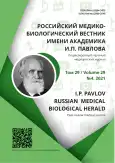冠心病和糖尿病患者的血压和心率变异性,钠-葡萄糖共转运蛋白2的作用研究
- 作者: Kotskaya A.V.1, Salaychuk E.V.2, Kudinov V.I.2, Terentyev V.P.2, Lankina M.S.2
-
隶属关系:
- Rostov Regional Clinical Hospital
- Rostov State Medical University
- 期: 卷 29, 编号 4 (2021)
- 页面: 489-496
- 栏目: Original study
- URL: https://journals.rcsi.science/pavlovj/article/view/72376
- DOI: https://doi.org/10.17816/PAVLOVJ72376
- ID: 72376
如何引用文章
详细
绪论在2型糖尿病(T2DM)患者中,加重冠心病(CHD)病程的一个因素是心血管自主神经病变(CADN),其猝死风险增加5倍。冠心病合并2型糖尿病患者心血管自主神经病变的患病率可达60%。经典心血管检查不允许检测心血管自主神经病变在临床前阶段。治疗2型糖尿病的现代方法是2型钠葡萄糖共转运体抑制剂,它已被证明具有心脏保护作用。
目的:冠心病合并2型糖尿病患者血压变异性(BPV)和心率变异性(HRV)变化的发生率分析及恩格列净对这些参数的影响。
材料与方法:对210例冠心病合并2型糖尿病患者(第一组)进行检查,年龄为64.5±6.7岁,男性为103例。对人体测量和生化参数进行了分析。每日监测心电图和血压,并进行了经典心血管检查。对照组为无碳水化合物代谢障碍的缺血性心脏病患者64例(第二组,n=64,66.4±2.3岁)。此外,在第一组检查的患者中,选取心率变异性和血压变异性受损的患者(n=42),但经典心血管试验总评分<4.0;他们被分为1G组(n=22):每天添加10—25mg恩格列净,1C组(n=20):继续先前进行的治疗。
结果:冠心病合并2型糖尿病患者中有22%的患者出现心血管自主神经病变,所有患者均有心率变异性和血压变异性异常。43%的患者在经典心血管试验得分正常(<4.0)的情况下检测到心率变异性和血压变异性的偏差。治疗6个月期间,HbA1c水平由8.38±0.56%降至6.9±0.26%(p<0.05),未使用恩格列净组HbA1c水平由8.28±0.32%降至7.30±0.29%(p<0.05)。恩格列净组每日平均心率(HR)由86.7±2.4次/分降至76.7±2.1次/分(p<0.05),昼夜节律指数由1.19±0.02升高至1.30±0.01(p<0.05),SDNN由106.1±2.21 ms上升至114.03±2.34 ms(p<0.05),收缩压变异性指数日间由22.9±1.7 ms下降至16.4±1.9%,p< 0.05,夜间由16.8±2.2 ms下降至12.3±2.6%,p< 0.05。
结论:检测到的心率变异性和血压变异性的变化可能是心血管自主神经病变的一种表现,如果经典心血管试验的总分< 4.0,则表明其处于临床前阶段。在恩格列净治疗的背景下,记录了心率变异性和血压变异性的正动态,证明了其能够改善自主神经系统的功能状态。
作者简介
Anastasia Kotskaya
Rostov Regional Clinical Hospital
Email: nastya369437@list.ru
ORCID iD: 0000-0002-7390-7792
SPIN 代码: 3961-3354
俄罗斯联邦, Rostov-on-Don
Elizaveta Salaychuk
Rostov State Medical University
Email: liza14.2014@mail.ru
ORCID iD: 0000-0002-5949-686X
MD, Cand. Sci. (Med)
俄罗斯联邦, Rostov-on-DonVladimir Kudinov
Rostov State Medical University
Email: endo-kudinov@mail.ru
MD, Cand. Sci. (Med)
俄罗斯联邦, Rostov-on-DonVladimir Terentyev
Rostov State Medical University
Email: vpterentev@mail.ru
ORCID iD: 0000-0003-3607-5832
MD, Dr. Sci. (Med.), Professor
俄罗斯联邦, Rostov-on-DonMaria Lankina
Rostov State Medical University
编辑信件的主要联系方式.
Email: maryhome@mail.ru
ORCID iD: 0000-0002-6121-7831
SPIN 代码: 4239-0906
俄罗斯联邦, Rostov-on-Don
参考
- The Demographic Yearbook of Russia. 2015. Statistical handbook / Rosstat. Moscow; 2015. (In Russ).
- Vishnevskii KA, Zemchenkov AYu, Gerasimchuk RP, et al. Pharmacoeconomic of CKD-MBD Treatment: Literature Review. Nephrology. 2018;22(1):38–51. (In Russ). doi: 10.24884/1561-6274-2018-22-1-38-51
- Ponikowski P, Voors AA, Anker SD, et al. 2016 ESC Guidelines for the diagnosis and treatment of acute and chronic he art failure: The Task Force for the diagnosis and treatment of acute and chronic heart failure of the European Society of Cardiology (ESC). Developed with the special contribution of the Heart Failure Association (HFA) of the ESC. European Heart Journal. 2016;37:2129–2200. doi: 10.1093/eurheartj/ehw128
- Roger LV, Go AS, Lloid–Jones DM, et al. Executive summary: heart disease and stroke statistics ― 2012 update: a report from the American Heart Association. Circulation. 2012;125(1):188–97. doi: 10.1161/CIR.0b013e3182456d46
- Pappachan JM, Sebastian J, Bino BC, et al. Cardiac autonomic neuropathy in diabetes mellitus: prevalence, risk factors and utility of corrected QT interval in the ECG for its diagnosis. Postgraduate Medical Journal. 2008;84(990):205–10. doi: 10.1136/pgmj.2007.064048
- Dedov II, Shestakova MV, Mayorov AYu, editors. Standards of specialized diabetes care. 9th ed. Moscow; 2019. (In Russ). doi: 10.14341/DM221S1
- Boitsov SA, Samorodskaya IV. Mortality and lost years of life as a result of cardiovascular premature deaths. Cardiovascular Therapy and Prevention. 2014;13(2):4–11. (In Russ). doi: 10.15829/1728-8800-2014-2-4-11
- Tkacheva ON, Vertkin AL. Diabeticheskaya avtonomnaya neyropatiya. Moscow: GEOTAR-Media; 2009. (In Russ).
- Sharonova LA, Verbovoy AF. The place of gliflozins in the management of type 2 diabetes mellitus. Farmateka. 2019;26(4):105–10. (In Russ). doi: 10.18565/pharmateca.2019.4.105-110
- Zinman B, Wanner C, Lachin JM, et al. Empagliflozin, Cardiovascular Outcomes, and Mortality in Type 2 Diabetes. The New England Journal of Medicine. 2015;373(2):2117–28. doi: 10.1056/NEJMoa1504720
- Neal B, Perkovic V, Mahaffey KW, et al. Canagliflozin and Cardiovascular and Renal Events in Type 2 Diabetes. The New England Journal of Medicine. 2017;377(7):644–57. doi: 10.1056/NEJMoa1611925
- Wiviott SD, Raz I, Bonaca MP, et al. Dapagliflozin and Cardiovascular Outcomes in Type 2 Diabetes. The New England Journal of Medicine. 2019;380(4):347–57. doi: 10.1056/NEJMoa1812389
- Rosenstock J., Frias J., Páll D., Charbonnel B., Pascu R., Saur D. et al. Effect of ertugliflozin on glucose control, body weight, blood pressure and bone density in type 2 diabetes mellitus inadequatelycontrolled on metformin monotherapy (VERTIS MET). Diabetes, Obesity & Metabolism. 2018;20(3):520–29. doi: 10.1111/dom.13103
- Bayevsky RM, Ivanov GG. Cardiac rhythm variability: the theoretical aspects and the opportunities of clinical application (lecture). Ultrasound and Functional Diagnostics. 2001;(3):106–27. (In Russ).
补充文件








